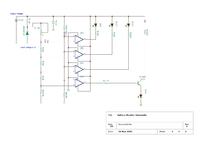angy
Full Member level 3
I am trying to make battery voltage indicator using LM3914.I want Led indicators to glow on 24V, 23V, 22V.
But it seems it cannot work on this voltage level as datasheet mentions higher voltage range should be 1.5 times the V+
I
But it seems it cannot work on this voltage level as datasheet mentions higher voltage range should be 1.5 times the V+
I


